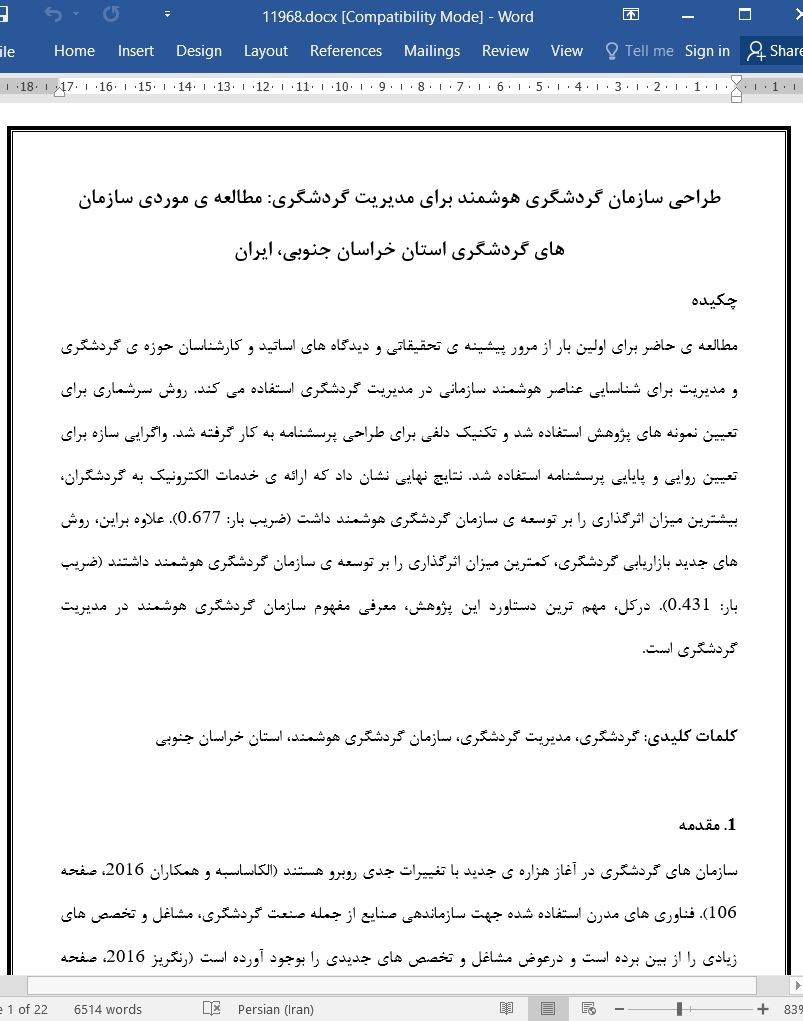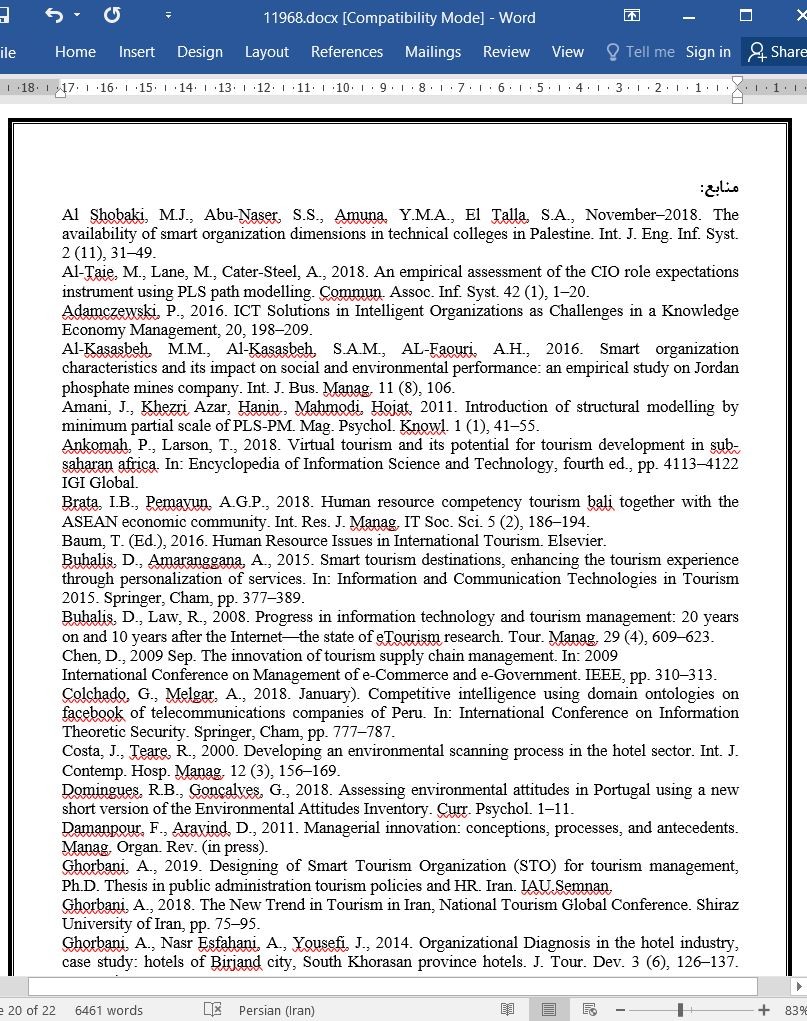
طراحی سازمان گردشگری هوشمند برای مدیریت گردشگری
چکیده
مطالعه ی حاضر برای اولین بار از مرور پیشینه ی تحقیقاتی و دیدگاه های اساتید و کارشناسان حوزه ی گردشگری و مدیریت برای شناسایی عناصر هوشمند سازمانی در مدیریت گردشگری استفاده می کند. روش سرشماری برای تعیین نمونه های پژوهش استفاده شد و تکنیک دلفی برای طراحی پرسشنامه به کار گرفته شد. واگرایی سازه برای تعیین روایی و پایایی پرسشنامه استفاده شد. نتایج نهایی نشان داد که ارائه ی خدمات الکترونیک به گردشگران، بیشترین میزان اثرگذاری را بر توسعه ی سازمان گردشگری هوشمند داشت (ضریب بار: 0.677). علاوه براین، روش های جدید بازاریابی گردشگری، کمترین میزان اثرگذاری را بر توسعه ی سازمان گردشگری هوشمند داشتند (ضریب بار: 0.431). درکل، مهم ترین دستاورد این پژوهش، معرفی مفهوم سازمان گردشگری هوشمند در مدیریت گردشگری است.
1. مقدمه
سازمان های گردشگری در آغاز هزاره ی جدید با تغییرات جدی روبرو هستند (الکاساسبه و همکاران 2016، صفحه 106). فناوری های مدرن استفاده شده جهت سازماندهی صنایع از جمله صنعت گردشگری، مشاغل و تخصص های زیادی را از بین برده است و درعوض مشاغل و تخصص های جدیدی را بوجود آورده است (رنگریز 2016، صفحه 14). از سوی دیگر، گردشگری، صنعت سازمان است و سازمان گردشگری، فرآیندی پیچیده همراه با واحدهای مختلف است. سازمان های حوزه ی گردشگری را می توان براساس مالکیت، نقش یا نوع فعالیت و طبقه ی مصرف کننده ی آنها تقسیم بندی کرد (گلدنر و ریچی 2007، صفحه 87). واحدهای کوچک کسب و کار مانند آژانس های مسافرتی و هتل های رویال، مثال هایی از سازمان های گردشگری هستند (قربانی و ایران 2013، صفحه 77). همچنین، گردشگری یکی از صنایع پیشتاز در بکارگیری فناروی های عصر جدید است (بوهالیس و لا 2008).
5. بحث و نتیجه گیری
نتایج این مطالعه نشان می دهد که توسعه ی هوش در صنعت گردشگری صرفاً از طریق فناوری ها و داده ها انجام نمی شود، بلکه، عوامل مختلفی در این زمینه دخیل هستند. مشابه نتایج لئونگ (2018)، این مطالعه مفهوم هوش را در شرکت های گردشگری آینده ارائه کرده است و زیست بوم گردشگری هوشمندی را پیشنهاد کرده است که برای تمام ذینفعان ارزش افزوده به ارمغان می آورد. در مطالعه ی تسویادیا و همکاران (2018) مشابه نتایج مطالعه ی حاضر، واقعیت مجازی و تجربه ی سفر هوشمند به عنوان ویژگی های گردشگری در عصر جدید درنظر گرفته شده اند. لیبراتو و همکاران (2018) بر اهمیت دسترسی به اینترنت در مقصد به خصوص در مکان هایی از جمله فرودگاه ها و هتل ها تأکید کرده اند و درنتیجه اهمیت خدمات الکترونیک را برای سازمان های گردشگری را نشان داده اند. ویژگی داخلی دیگر سازمان گردشگری هوشمند در این مطالعه، روش های جدید بازاریابی گردشگری مانند واقعیت مجازی به منظور کمک به کاهش ریسک خرید گردشگران می باشد. گریفین و همکاران (2017) استدلال کردند که واقعیت مجازی به عنوان یک روش جدید بازاریابی گردشگری، اثر مثبتی بر تصویر مقصد و بیشتر گویه های موجود در جذابیت تصویر مقصد و کارآمدی تبلیغات می گذارد.
Abstract
The present study uses a review of the literature and the views of tourism and management professors and experts in order to the identification of organizational intelligence elements in tourism management (STO) for the first time. The census method was used to determine the research sample and the Delphi technique was used to design the questionnaire. Construct divergence was then used to determine the validity and reliability of the questionnaire. The final results indicated that providing e-services for tourists had the greatest impact on the development of STO (loading factor: 0.677). Moreover, New Tourism Marketing Methods (NTMM) had the least effect on the development of STO (loading factor: 0.431). Overall, the most important achievement of the present research is introducing the concept of STO in tourism management.
1. Introduction
Tourism organizations are facing radical changes at the beginning of the new millennium (Al-Kasasbeh et al., 2016:106). Modern technologies used for the organization of industries such as the tourism industry have eliminated a number of occupations and specializations and have instead created some new occupations and specializations (Rangriz, 2016:14). On the other hand, tourism is the organization's industry and the organization of tourism is a complex process with several units. Organizations in tourism can be classified by ownership, function or type of activity and their consumer class (Goeldner and Ritchie, 2007:87). Small business units such as travel agencies and Royal hotels are examples of tourism organizations (Ghorbani and Iran, 2013:77). Also, tourism is one of the pioneer industries in the application of new age technologies (Buhalis and Law, 2008).
5. Discussion and conclusion
The results of this study indicate that the development of intelligence in the tourism industry is not solely by technologies and data; instead, various factors are at play. Similar to Leung's results (2018), the present study conceptualized intelligence in tourism enterprises of the future and proposed a smart tourism ecosystem that adds value to all stakeholders. In the study by Tussyadiah et al. (2018), similar to the results of the present study, virtual reality and smart travel experience are listed as features of tourism in the new era. Liberato et al. (2018) emphasized the internet access importance at the destination, particularly in places including airports and hotels, and thus demonstrated the importance of e-services for tourism organizations. Another internal feature of STO in the present study is new tourism marketing methods such as VR to help reduce the risk of shopping tourists. Griffin et al. (2017) argued that, as a new tourism marketing method, VR positively affects the destination image and most items within the conative destination image and the effectiveness of the advertisement. Offering smart experience and complementary activities were the other dimensions of STO in this research.
چکیده
1. مقدمه
2. نظریه
2.1. هوش ساختاری
2.2. هوش انسانی و سازمانی
2.3. هوش فناوری
2.4. هوش رقابتی
2.5. هوش محیطی
2.6. هوش هیجانی
2.7. بُعد داخلی سازمان گردشگری هوشمند
2.8. خدمات الکترونیک
2.9. کارمندان آموزش دیده و مسلط به زبان
2.10. روش های جدید بازاریابی گردشگری
3. روش پژوهش
3.1. ارائه ی مدل اولیه و معرفی فرضیه ی پژوهش
3.2. تحلیل داده با نرم افزار SPSS (تحلیل توصیفی و آزمون های نرمال بودن داده ها)
3.5. تحلیل داده با نرم افزار Smart PLS
4. نتایج
5. بحث و نتیجه گیری
مشارکت نویسندگان
تأمین مالی
تعارض منافع
اطلاعات بیشتر
منابع
Abstract
1. Introduction
2. Theory
2.1. Structural intelligence
2.2. Human and organizational intelligence
2.3. Technological intelligence (TI)
2.4. Competitive Intelligence (CI)
2.5. Environmental intelligence
2.6. Emotional intelligence
2.7. The internal dimension of the smart tourism organization
2.8. E-services
2.9. Trained and fluent-in-language staffs
2.10. New tourism marketing methods (NTMM)
2.11. Organizational innovation (OI)
2.12. Complementary activities
2.13. Offering a smart experience
3. Methodology
3.1. Presenting the initial model and setting the research hypothesis
3.2. Data analysis with SPSS (descriptive analysis and normality tests)
4. Results
5. Discussion and conclusion
Declarations
Author contribution statement
Funding statement
Competing interest statement
Additional information
Appendix A. Supplementary data
References
- ترجمه فارسی مقاله با فرمت ورد (word) با قابلیت ویرایش، بدون آرم سایت ای ترجمه
- ترجمه فارسی مقاله با فرمت pdf، بدون آرم سایت ای ترجمه



